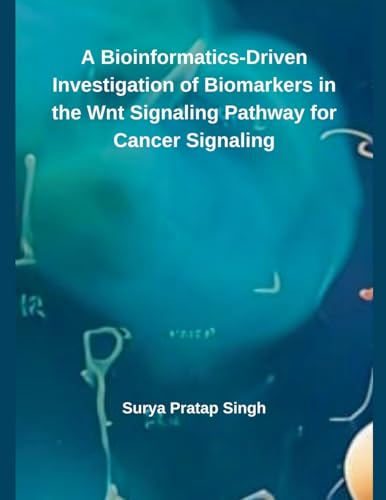Artículos relacionados a A Bioinformatics-Driven Investigation of Biomarkers...
A Bioinformatics-Driven Investigation of Biomarkers in the Wnt Signaling Pathway for Cancer Signaling - Tapa blanda

Sinopsis
Cell signaling is a way of communication among the living cells and involves the processing of biochemical information to regulate metabolic and cellular activities of the organism. The process of signaling initiates with a chemical species (i.e. ligands or signaling molecules) and ends with the cellular responses. The signal molecules are recognized by the receptors on the surface of target cells and the message is transferred inside the cell in series of steps, the signal transduction pathway, to produce the desired effects. Many signaling pathways have been studied for their involvement in cellular processes such as differentiation and proliferation. One such pathway is Wnt-signaling pathway which is an ancient and highly conserved among all metazoans; it is known to have roles in regulating life processes such as embryonic development, cell growth and survival, cell differentiation, migration and polarity (Wodarz et al., 1998). The term Wnt is derived from the name of two genes viz. wingless gene of Drosophila which is a segment polarity gene and its vertebrate homolog integrated or int-1 (Komiya and Habas, 2008). The extracellular signaling molecule of this pathway (i.e. ligand) is a glycoprotein known as Wnt, which binds to, and dimerize, two receptors namely LRP6/5 and Fz. The downstream signal is transported to the nucleus and promotes the transcription of Wnt responsive genes which ultimately regulate a wide variety of cellular processes including cell fate determination, motility, polarity, primary axis formation, stem cell renewal and organogenesis. The intracellular
"Sinopsis" puede pertenecer a otra edición de este libro.
EUR 2,27 gastos de envío en Estados Unidos de America
Destinos, gastos y plazos de envíoComprar nuevo
Ver este artículoEUR 2,27 gastos de envío en Estados Unidos de America
Destinos, gastos y plazos de envíoResultados de la búsqueda para A Bioinformatics-Driven Investigation of Biomarkers...
A Bioinformatics-Driven Investigation of Biomarkers in the Wnt Signaling Pathway for Cancer Signaling
Librería: GreatBookPrices, Columbia, MD, Estados Unidos de America
Condición: New. Nº de ref. del artículo: 48919444-n
Cantidad disponible: Más de 20 disponibles
A Bioinformatics-Driven Investigation of Biomarkers in the Wnt Signaling Pathway for Cancer Signaling
Librería: California Books, Miami, FL, Estados Unidos de America
Condición: New. Nº de ref. del artículo: I-9798227849342
Cantidad disponible: Más de 20 disponibles
A Bioinformatics-Driven Investigation of Biomarkers in the Wnt Signaling Pathway for Cancer Signaling
Librería: GreatBookPrices, Columbia, MD, Estados Unidos de America
Condición: As New. Unread book in perfect condition. Nº de ref. del artículo: 48919444
Cantidad disponible: Más de 20 disponibles
A Bioinformatics-Driven Investigation of Biomarkers in the Wnt Signaling Pathway for Cancer Signaling
Impresión bajo demandaLibrería: PBShop.store US, Wood Dale, IL, Estados Unidos de America
PAP. Condición: New. New Book. Shipped from UK. THIS BOOK IS PRINTED ON DEMAND. Established seller since 2000. Nº de ref. del artículo: L0-9798227849342
Cantidad disponible: Más de 20 disponibles
A Bioinformatics-Driven Investigation of Biomarkers in the Wnt Signaling Pathway for Cancer Signaling
Impresión bajo demandaLibrería: PBShop.store UK, Fairford, GLOS, Reino Unido
PAP. Condición: New. New Book. Delivered from our UK warehouse in 4 to 14 business days. THIS BOOK IS PRINTED ON DEMAND. Established seller since 2000. Nº de ref. del artículo: L0-9798227849342
Cantidad disponible: Más de 20 disponibles
A Bioinformatics-Driven Investigation of Biomarkers in the Wnt Signaling Pathway for Cancer Signaling
Librería: Rarewaves USA, OSWEGO, IL, Estados Unidos de America
Paperback. Condición: New. Nº de ref. del artículo: LU-9798227849342
Cantidad disponible: Más de 20 disponibles
A Bioinformatics-Driven Investigation of Biomarkers in the Wnt Signaling Pathway for Cancer Signaling
Librería: Rarewaves.com USA, London, LONDO, Reino Unido
Paperback. Condición: New. Nº de ref. del artículo: LU-9798227849342
Cantidad disponible: Más de 20 disponibles
A Bioinformatics-Driven Investigation of Biomarkers in the Wnt Signaling Pathway for Cancer Signaling
Librería: Ria Christie Collections, Uxbridge, Reino Unido
Condición: New. In. Nº de ref. del artículo: ria9798227849342_new
Cantidad disponible: Más de 20 disponibles
A Bioinformatics-Driven Investigation of Biomarkers in the Wnt Signaling Pathway for Cancer Signaling
Librería: GreatBookPricesUK, Woodford Green, Reino Unido
Condición: New. Nº de ref. del artículo: 48919444-n
Cantidad disponible: Más de 20 disponibles
A Bioinformatics-Driven Investigation of Biomarkers in the Wnt Signaling Pathway for Cancer Signaling
Librería: GreatBookPricesUK, Woodford Green, Reino Unido
Condición: As New. Unread book in perfect condition. Nº de ref. del artículo: 48919444
Cantidad disponible: Más de 20 disponibles
